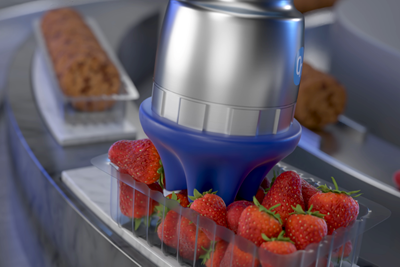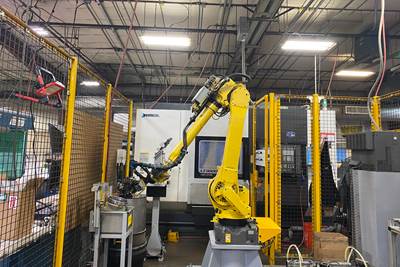Share






Automate 2024 was held May 6-9 at Chicago’s McCormick Place.Photos provided by Julia Hider, MMS.
I expected my first experience at Automate, held May 6-9 at Chicago’s McCormick Place, to include an array of robots (arms, dogs, humanoids, AGVs and so on) performing all manner of complex tasks. And while I did see a lot of cool and interesting demonstrations (scroll down to the last section to watch robots making cocktails!), much of the emphasis at the show this year was on the software behind the automation. Many companies said that for robotics and other forms of automation to become more widespread, they need to be easier to use. Software can help users design and simulate automation systems, simplify and speed programming (or even eliminate the need for programming at all), give robots the power of vision to complete more complex tasks, and monitor systems to ensure they’re running as efficiently as possible. Here are some of the most interesting software-driven technologies and applications I saw at Automate 2024:

Vention’s software enables users to design, program, deploy, change and redeploy an automation system. It also includes machine analytics and remote service/support.
Vention
Vention focuses on making automation more accessible to small- and medium-sized manufacturers by offering plug-and-play hardware. Vention produces all components of these systems in house with the exception of the robot and end-of-arm tooling. This enables the safety devices, motors structural equipment and more to be modular and customizable. But according to CTO Francois Giguere, “The power of Vention is the software.” Users can go to Vention’s website and build an automation system complete with robots, end effectors, structural equipment, safety components and more. Then users can simulate the system within the software, using STEP files of the machines involved. All of this is free, and the company even provides free consulting services for first-time users. Once the system has been shipped and set up at the facility, users can program and deploy it through Vention as well. The software also includes machine analytics, remote support and service and the ability to redesign and redeploy an automation system. The modularity of Vention’s components makes this relatively easy, along with free consulting from the company’s experts.

Siemens’ Robot Pick AI uses deep learning to enable a robot equipped with a 3D camera to pick and place unknown objects without training.
Siemens
Siemens’ booth featured a number of software products for robots, such as Industrial Copilot, a function in Siemens’ Totally Integrated Automation (TIA) Portal that uses generative AI to aid industrial engineering tasks by generating code, finding errors and giving operators advice on how to fix them. Siemens is also using AI to aid machine vision in its Robot Pick AI program. This system uses deep learning to enable a six-axis robot equipped with a 3D camera to pick and place unknown objects without training. A UR cobot was showing these capabilities in the booth, performing a bin-picking task. The company also had two examples of how robots can function as machine tools with the help of its Sinumerik One CNC. One demo featured a robot functioning as a DED 3D printer, while the other robot was using CNC milling to machine battery trays. The benefit of using a robot as a machine tool is that it’s more flexible.

Comau’s MI.RA/3D system provides a cheaper 3D vision solution by using a 2D camera to capture images from multiple angles of a part, combining them to create a 3D image.
Comau
3D vision systems are key to unlocking more complex applications for robots, but they can be challenging to implement compared to 2D vision systems. Comau was featuring a possible solution to this issue in its booth. Its MI.RA/3D system uses a 2D camera to captures images from multiple angles of a part, stitching them together to create a 3D image. This is a cheaper and easier solution for 3D vision.

Ellison Technology’s AutoPilot machine tending solution uses OnRobot’s D:Ploy software to enable users to program the system using only a few pieces of information.
OnRobot
OnRobot’s D:PLOY software was on display in Doosan Robotics’ booth as a component in Ellison Technology’s AutoPilot machine tending solution. AutoPilot includes a Doosan Robotics arm, along with an OnRobot end effector, movable base with a tray for locating parts, and a tablet with OnRobot’s D:Ploy software, which programs the system with a few pieces of information. Users can quickly implement automation and re-deploy the system in a high-mix, low-volume environment.
Mobile Industrial Robots (MiR)
Mobile Industrial Robots (MiR) is a producer of autonomous mobile robots (AMRs). The company has a number of AMRs in its portfolio with different payload capacities, and modules such as hooks, conveyors, racks and even cobot arms from sister company Universal Robots via its MiR Go ecosystem can be mounted onto the AMRs to enable them to complete different tasks. The company also has several software solutions, including MiR Fleet, which enables visibility and control of all AMRs in a facility. MiR Fleet can program robots and assign tasks based on capability and availability. MiR Insights is a monitoring platform for AMRs, through which users can users can minimize AMR downtime. As they travel through a facility, AMRs can gather data such as number of missions completed, miles driven, manual interventions, WiFi signal changes and areas with high traffic and robotic intersections to improve efficiency.

This inspection application from Universal Robots uses Nvidia’s CuMotion package to speed robotic path planning by as much as 80%.
Universal Robots
Universal Robots was also showcasing its use of AI, this time through a partnership with Nvidia. The company was showcasing an inspection application that uses Nvidia’s CuMotion package to speed robotic path planning by as much as 80%. UR is also working closely with Nvidia to incorporate AI tools into its PolyScope X operating software in the near future.

Olis uses an industrial PC and camera to provide secure, remote service for robotic cells.
Olis
Olis offers what co-founder and CEO Fredrik Ryden calls a “Ring camera for robots,” using an industrial PC and a camera to provide remote assistance for robotic cells. Ryden notes that when a cell goes down, many potential issues can look the same to the untrained eye. For example, a robot might seem like it’s broken, but the actual issue is that it was fed out-of-spec material. In a demo on a palletizing cell at the Kawasaki Robotics booth, Ryden demonstrated how Olis enables an expert (provided by either the integrator or end user) to remotely control the cell, using the camera to diagnose and solve problems. Because it doesn’t require WiFi, it’s a secure option for remote service.

WiBotic’s Commander software optimizes the charging strategy for autonomous fleets of robots, while its universal wireless charging system extends battery life, eliminates charge point failures and improves safety.
WiBotic
As fleets of autonomous robots grow within facilities, companies might need to consider a strategy for charging them. These robots know when they need to recharge, typically returning to a charging station when they’re at 20% battery life. But this could create a situation where multiple robots are unavailable at the same time. WiBotic’s Commander software controls the fleet’s charging strategy using an opportunistic model to maximize uptime. WiBotic also provides a universal, wireless charging structure, which can have a number of benefits. Matt Carlson, VP of business development, notes that mixed fleets (or multiple multiple brands) is common among AMR users. Wireless charging could also extend the life of expensive batteries, eliminate charge point failures and increase safety within facilities.
Kuka
In its own booth in the Education Pavilion, Kuka was showcasing several applications, including a Lego robot that students can program and simulate offline using Kuka’s software, as well as a robotic arm integrated by One-Off Robotics that was being used as a polymer 3D printer. The company was also represented in several other educational programs’ booths, including Oakland University, which is working with the supplier to develop a protocol to enable augmented reality (AR) to interface with the robot. This could enable visualization of robotic paths, simulating cycle times and programming of robots using AR.
Doosan Robotics
Doosan Robotics had a number of interesting demonstrations in its booth — I arrived just as a musician was finishing a performance with electric drums mounted on robotic arms. In addition to industrial automation applications, with demonstrations ranging from palletizing to machine tending and surface finishing, I saw several demonstrations of its food-grade E series robots, including an automated cake decorating line, a robot barista named Dr. Presso and a robot mixologist named Mixmaster Moodie. Not only do Mixmaster Moodie’s robots make cocktails (or mocktails), they do so using a recipe generated by ChatGPT, chosen based on the emotions detected in a photo of the patron.
Related Content
Increasing Productivity with Digitalization and AI
Job shops are implementing automation and digitalization into workflows to eliminate set up time and increase repeatability in production.
Read MoreUsing the Toolchanger to Automate Production
Taking advantage of a feature that’s already on the machine tool, Lang’s Haubex system uses the toolchanger to move and store parts, making it an easy-to-use and cost-effective automation solution.
Read MoreLean Approach to Automated Machine Tending Delivers Quicker Paths to Success
Almost any shop can automate at least some of its production, even in low-volume, high-mix applications. The key to getting started is finding the simplest solutions that fit your requirements. It helps to work with an automation partner that understands your needs.
Read More3 Ways Artificial Intelligence Will Revolutionize Machine Shops
AI will become a tool to increase productivity in the same way that robotics has.
Read MoreRead Next
The Softer Side of Robots: Increasing Automation’s Adaptability
Robotic applications are expanding thanks to rubber and silicone-based systems that can handle fragile materials or parts in varying sizes and shapes.
Read MoreProtecting Your Automation Investments
Shops need to look at their people, processes and technology to get the most of out their automation systems.
Read MoreSeeing Is Believing: 3D Vision System Enables Bin-Picking Robot
With the help of a 3D vision system and robotic arms from FANUC, MetalQuest was able to automate a physically challenging bin-picking task.
Read More
































